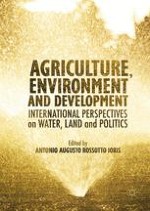2016 | OriginalPaper | Chapter
7. Water Incorporated in Agricultural Production: Water Balance Considerations
Authors : Renato de Toledo Peres, José Gilberto de Souza
Published in: Agriculture, Environment and Development
Publisher: Springer International Publishing
Activate our intelligent search to find suitable subject content or patents.
Select sections of text to find matching patents with Artificial Intelligence. powered by
Select sections of text to find additional relevant content using AI-assisted search. powered by
